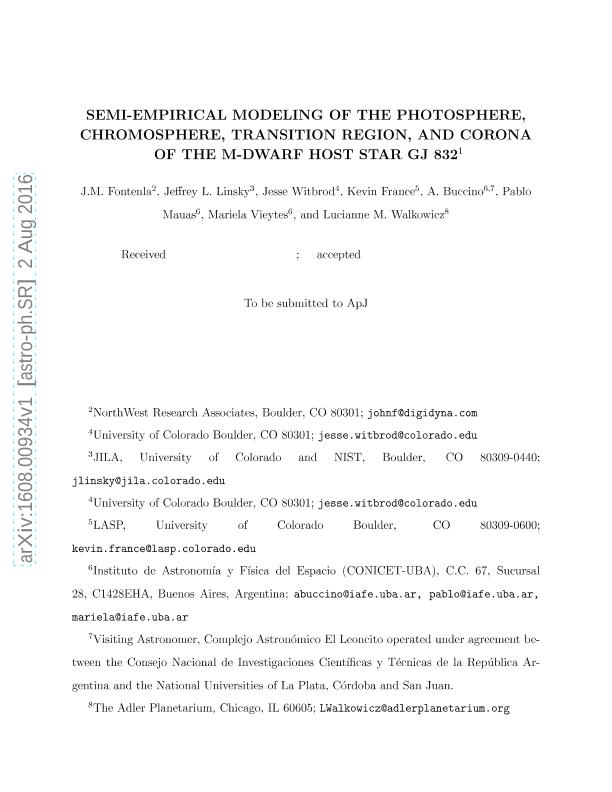Mostrar el registro sencillo del ítem
dc.contributor.author
Fontenla, J. M.
dc.contributor.author
Linsky, J. L.
dc.contributor.author
Witbrod, J.
dc.contributor.author
France, K.
dc.contributor.author
Buccino, Andrea Paola

dc.contributor.author
Mauas, Pablo Jacobo David

dc.contributor.author
Vieytes, Mariela Cristina

dc.contributor.author
Walkowicz, L.
dc.date.available
2017-08-01T18:01:19Z
dc.date.issued
2016-10
dc.identifier.citation
Fontenla, J. M.; Linsky, J. L.; Witbrod, J.; France, K.; Buccino, Andrea Paola; et al.; Semi-empirical Modeling of the Photosphere, Chromosphere, Transition Region, and Corona of the M-dwarf Host Star GJ 832; IOP Publishing; Astrophysical Journal; 830; 2; 10-2016; 154,1-18
dc.identifier.issn
0004-637X
dc.identifier.uri
http://hdl.handle.net/11336/21732
dc.description.abstract
Stellar radiation from X-rays to the visible provides the energy thatcontrols the photochemistry and mass loss from exoplanet atmospheres.The important extreme ultraviolet (EUV) region (10-91.2 nm) isinaccessible and should be computed from a reliable stellar model. It isessential to understand the formation regions and physical processesresponsible for the various stellar emission features to predict how thespectral energy distribution varies with age and activity levels. Wecompute a state-of-the-art semi-empirical atmospheric model and theemergent high-resolution synthetic spectrum of the moderately active M2V star GJ 832 as the first of a series of models for stars withdifferent activity levels. We construct a one-dimensional simple modelfor the physical structure of the star?s chromosphere,chromosphere-corona transition region, and corona using non-LTEradiative transfer techniques and many molecular lines. The synthesizedspectrum for this model fits the continuum and lines across theUV-to-optical spectrum. Particular emphasis is given to the emissionlines at wavelengths that are shorter than 300 nm observed with theHubble Space Telescope, which have important effects on thephotochemistry of the exoplanet atmospheres. The FUV line ratiosindicate that the transition region of GJ 832 is more biased to hottermaterial than that of the quiet Sun. The excellent agreement of ourcomputed EUV luminosity with that obtained by two other techniquesindicates that our model predicts reliable EUV emission from GJ 832. Wefind that the unobserved EUV flux of GJ 832, which heats the outeratmospheres of exoplanets and drives their mass loss, is comparable tothe active Sun.
dc.format
application/pdf
dc.language.iso
eng
dc.publisher
IOP Publishing

dc.rights
info:eu-repo/semantics/openAccess
dc.rights.uri
https://creativecommons.org/licenses/by-nc-sa/2.5/ar/
dc.subject
Planetstar Interactions
dc.subject
Ultraviolet: Stars
dc.subject
Stars: Late-Type
dc.subject
Stars: Individual: Gj 832
dc.subject
Stars: Coronae
dc.subject
Stars: Chromospheres
dc.subject.classification
Astronomía

dc.subject.classification
Ciencias Físicas

dc.subject.classification
CIENCIAS NATURALES Y EXACTAS

dc.title
Semi-empirical Modeling of the Photosphere, Chromosphere, Transition Region, and Corona of the M-dwarf Host Star GJ 832
dc.type
info:eu-repo/semantics/article
dc.type
info:ar-repo/semantics/artículo
dc.type
info:eu-repo/semantics/publishedVersion
dc.date.updated
2017-07-31T18:04:30Z
dc.journal.volume
830
dc.journal.number
2
dc.journal.pagination
154,1-18
dc.journal.pais
Reino Unido

dc.journal.ciudad
Londres
dc.description.fil
Fil: Fontenla, J. M.. State University Of Colorado Boulder; Estados Unidos
dc.description.fil
Fil: Linsky, J. L.. State University Of Colorado Boulder; Estados Unidos
dc.description.fil
Fil: Witbrod, J.. State University Of Colorado Boulder; Estados Unidos
dc.description.fil
Fil: France, K.. State University Of Colorado Boulder; Estados Unidos
dc.description.fil
Fil: Buccino, Andrea Paola. Consejo Nacional de Investigaciónes Científicas y Técnicas. Oficina de Coordinación Administrativa Ciudad Universitaria. Instituto de Astronomía y Física del Espacio. - Universidad de Buenos Aires. Facultad de Ciencias Exactas y Naturales. Instituto de Astronomía y Física del Espacio; Argentina
dc.description.fil
Fil: Mauas, Pablo Jacobo David. Consejo Nacional de Investigaciónes Científicas y Técnicas. Oficina de Coordinación Administrativa Ciudad Universitaria. Instituto de Astronomía y Física del Espacio. - Universidad de Buenos Aires. Facultad de Ciencias Exactas y Naturales. Instituto de Astronomía y Física del Espacio; Argentina
dc.description.fil
Fil: Vieytes, Mariela Cristina. Consejo Nacional de Investigaciónes Científicas y Técnicas. Oficina de Coordinación Administrativa Ciudad Universitaria. Instituto de Astronomía y Física del Espacio. - Universidad de Buenos Aires. Facultad de Ciencias Exactas y Naturales. Instituto de Astronomía y Física del Espacio; Argentina
dc.description.fil
Fil: Walkowicz, L.. The Adler Planetarium; Estados Unidos
dc.journal.title
Astrophysical Journal

dc.relation.alternativeid
info:eu-repo/semantics/altIdentifier/url/http://iopscience.iop.org/article/10.3847/0004-637X/830/2/154
dc.relation.alternativeid
info:eu-repo/semantics/altIdentifier/doi/http://dx.doi.org/10.3847/0004-637X/830/2/154
dc.relation.alternativeid
info:eu-repo/semantics/altIdentifier/url/https://arxiv.org/abs/1608.00934
Archivos asociados
